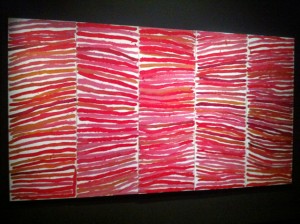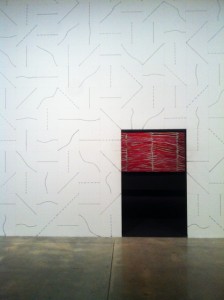The whole lot: ‘Theatre of the world’ at MONA
The simplest signs or gestures, like […] lines of paint or holes, whether they come from an Aboriginal woman artist, or from Papua New Guinea, or from an Italian artist, Lucio Fontana, can all become symbols of the whole of the totality, that is, the representation of immaterial life.
Jean-Hubert Martin, 2012.
Responding to prompts to describe what she painted, the late Anmatyerre painter Emily Kame Kngwarreye famously stated, ‘(the) whole lot … that’s what I paint’.
This eliptical statement can be traced throughout the considerable literature on Kngwarreye’s work. It’s generally established that she was referring, in a holistic sense, to Alhalkere, her traditional country, and all that it embodied to a senior Anmatyerre woman of her generation.
But the provocation that her words hold for an art world inflected by the historical dominance of modernism still endures, a kind of ghost that haunts her work’s reception and points to another, more fraught possibilty.
Here ‘the whole lot’ becomes a statement of affinity, proof of art’s universal aspect.
This would go something like, ‘painting, and in particular abstraction, can heroically embody everything, even as it swings closer and closer to an apparent nothingness’.
This ‘doubling’—evident in so much work like Kngwarreye’s—is endlessly fascinating but it ultimately does your head in. The contradictions are almost immediately compounded by the historical anxieties that are still so apparent in Australia. So it’s not abstraction, but it is, or it is abstraction, but it’s not.
—
In his brilliant, sprawling exhibition Theatre of the world, just closed at MONA, Jean-Hubert Martin not so much ignored these difficulties as conflated them. Prevailing categories were endlessly dismantled only to be recast in new light, opening the doors to a kind of free-associative rollercoaster of sights and sensations.
He said somewhere that ‘the pleasures of a museum should be like that of a concert hall, or theatre’. I’d hazard that his exhibition was more unique than either; a dizzying experience where a kind of naïve enchantment quickly became the only common baseline.
On Martin’s stage a line is never just a line and art’s universal aspect is a given. Paintings like Kngwarreye’s become nodes within a vast network that traces new, more propositional ways of thinking through time. As an exhibition you might have hated it for its audacity if it hadn’t succeeded in such a compelling and entertaining way.
Theatre of the world, MONA, Hobart, 23 June 2012 – 8 April 2013.






